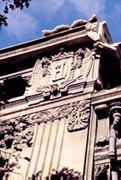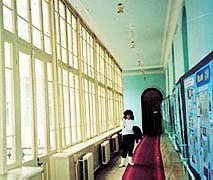|

Winter
1998 (6.4)
Architecture
of the Oil Baron Period
-
- Introduction
by Betty Blair
Compilation and building descriptions by Fuad Akhundov
Shamil Fatullayev, Fakhreddin Miralayev and Jala Garibova
For specific
buildings of Oil Baron's period, click below
Short Story - Mammadguluzade
"Maybe
They'll Give It All Back" (AI 7.1).
Introduction
If buildings
could speak, the palatial mansions built by Oil Barons at the
turn of last century would, no doubt, leave us spellbound with
their tales. At that time, Azerbaijan was producing more than
50 percent of the world's oil. It was a veritable "oil boom"
and set off a frenzy of architectural activity. Hundreds of luxurious
residences were built between 1885 and about 1915 until everything
came to a sudden halt when the Bolsheviks took power (1920) and
set up a communist government.
Entrepreneurs who had been so admired and emulated were branded
as bourgeois and "enemies of the people." Most of them
fled the country. Others committed suicide (Mukhtarov, page 40)
or were killed (Ashurbeyov, 34). Those who survived saw their
properties confiscated, and with few exceptions, residences were
sub-divided into multiple dwellings. Perhaps, the word "carved
up" would be more accurate.
  When we began researching
the architecture of the Oil Baron period, we thought it would
be a very easy topic. Hundreds of these mansions are concentrated
in the center of Baku. Thousands of people pass by them everyday.
But the subject turned out to be extraordinarily difficult. An
incredible amount of the history has already been lost. Here
and there, a few female descendents in their late 80s and 90s
offer some insight. But more and more, their memories are failing.
After exhausting all known experts in the field, we reluctantly
arrived at the conclusion that much of the information of the
Oil Baron period is absolutely lost. When we began researching
the architecture of the Oil Baron period, we thought it would
be a very easy topic. Hundreds of these mansions are concentrated
in the center of Baku. Thousands of people pass by them everyday.
But the subject turned out to be extraordinarily difficult. An
incredible amount of the history has already been lost. Here
and there, a few female descendents in their late 80s and 90s
offer some insight. But more and more, their memories are failing.
After exhausting all known experts in the field, we reluctantly
arrived at the conclusion that much of the information of the
Oil Baron period is absolutely lost.
Understandably, when the Bolsheviks took power, any identification
with Oil Barons could put one in jeopardy. Few wanted to risk
being "politically incorrect." The consequences were
too severe. The philosophical basis for the new Soviet man was
antithetical to the entrepreneurial individualism and capitalism
that the previous epoch had built upon. Now 80 years later, many
of the details have been erased from the collective memory. For
example, it's impossible to find out who owned many of these
buildings and what happened to them after the Bolsheviks came
to power.
Nevertheless, the buildings of the Oil Baron period are among
the most vibrant samples of architecture in Baku and are clearly
differentiated from all other buildings before and after. Here
we define some of their distinguishing features:
Distinguishing
Features of Oil Baron Period
1. Ornate
Characteristic
of Eastern aesthetics is a love for intricate detail. Fortunately,
limestone, the construction material that is indigenous to the
region and which has been quarried near Baku since ancient times,
yields itself easily to being sculpted and hewn. One of the quickest
ways to identify buildings of the Oil Baron period is by the
elaborate carvings that grace the facades of these buildings,
especially the entrances. The sculptured patterns are endless-fauna,
flora, fruit and even imaginative creatures of fantasy-griffins,
dragons and more.
2. Plasticity of
elements
Almost
like putty or clay, the shapes of the basic elements are very
three-dimensional. Arches, cornices, columns, domes, balconies
all "pop-out" from the flat surface of the building.
Shadow and shade create even more perception of depth. This style
contrasts most dramatically with the Khrushchev period of the
1960s when ornamental features were forbidden.
3. Synthesis
East and West
Eastern and Western styles are creatively synthesized into a
new form. Rich eclectic combinations result from merging Neo-classical,
German and Italian Renaissance Revival, French Gothic, Art Nouveau
with Eastern styles of Safavid, Persian, Cairo, Ottoman and Magrebi.
No two buildings are identical.
4. Treatment of corners
Because
the streets were relatively narrow in the center of the city,
there was a tendency to avoid sharp corners on buildings, especially
where streets intersected. Many architects created a design with
"cut corners". In fact, this solution draws even more
attention to the building itself. Also corners are often emphasized
with balconies and domes.
5. Climactic Conditions
The
inner courtyard is indigenous to the region and provides an opportunity
to create a garden-like atmosphere. As Muslim women at the time
traditionally wore veils and could not go out in the streets
unaccompanied, this architectural feature also provided the women
and children a protective environment out-of-doors. Often, the
side of the building facing the courtyard consists of a hallway
filled with rows of windows providing ample light to the living
space.
From Azerbaijan
International
(6.4) Winter 1998.
© Azerbaijan International 1998. All rights reserved.
Back to Index
AI 6.4 (Winter 1998)
AI Home
| Magazine
Choice | Topics
| Store
| Contact
us
|




